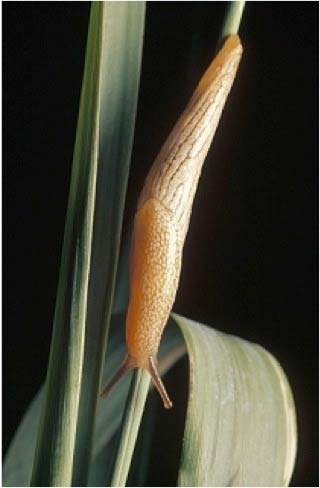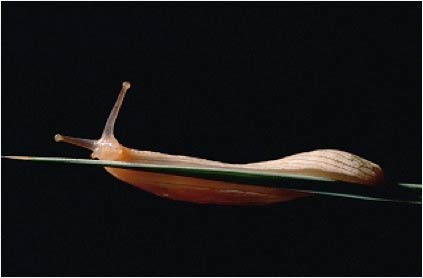Urocyclus flavescens
Family
Urocyclidae
Species
Urocyclus flavescens (Keferstein, 1866)
Common name
African banana slug
Description
The color of this slugSlug:
A snail that either does not possess a shell or has one that is very reduced (no definite coiling) or internal.
is variable, ranging from pale yellow, lemon-yellow, green-yellow, yellow-brown to gray. The mantleMantle:
A fleshy, membranous covering of the anterior portion of the body of a mollusc. It secretes the materials that form the shell.
is typically greenish, and generally covers the anteriorAnterior:
Directional term: located in front. Nearer the head or front end of a shell.
third of the dorsum. The dorsal surface is typically uniform in color, except for two faint lateral stripes. In rare cases, there may exist a third stripe medially. A mixture of color variants typically exists in a single population. This slender slugSlug:
A snail that either does not possess a shell or has one that is very reduced (no definite coiling) or internal.
will attain a maximum length of 60 mm. The body of the African banana slugSlug:
A snail that either does not possess a shell or has one that is very reduced (no definite coiling) or internal.
quickly tapers from front to back, giving an unusually angular appearance to the posteriorPosterior:
Directional term: the rear or tail end of an animal.
section of the animal. A keelKeel:
Also known as the carina. This is a longitudinal ridge that runs dorsally along the apex of the tail of the animal.
is absent. There are also minute longitudinal grooves on the dorsum. These grooves are transected by shorter transverse grooves. There is a prominent caudal pore at the posteriorPosterior:
Directional term: the rear or tail end of an animal.
end of the animal. The middle of the animal is characteristically vaulted (humped), causing the tail to appear narrower than the body. The sole of the footFoot:
The muscular organ on the undersurface of the body of a mollusc upon which the animal rests or uses to crawl.
is tripartiteTripartite:
Having three distinct section/regions.
with the middle appearing narrower than the sides. The footFoot:
The muscular organ on the undersurface of the body of a mollusc upon which the animal rests or uses to crawl.
fringe is typically uniform (no vertical bands).
Native range
East Africa
Distribution
Africa: Southern
Ecology
The African banana slugSlug:
A snail that either does not possess a shell or has one that is very reduced (no definite coiling) or internal.
has been documented as a pest of banana. This slugSlug:
A snail that either does not possess a shell or has one that is very reduced (no definite coiling) or internal.
will damage the fruit by rasping at the peel. This results in necroticNecrotic:
Dead or dying tissue. Often brown to black in color.
scaring which reduces the marketability (reduced sales and outright rejection of the fruit) of the fruit. Entire bunches can be lost, and losses of greater than 10 % is not atypical. It can be found in banana plantations, forests (inside and at the edge), dune forest and gardens. The slugs do not seem to have microhabitat preferences, and they can be found out in the open, in grass, under logs and buried between the hands on banana bunches. This species colonize habitats ranging from sea level up to an altitude of 1400 m. This species is nocturnalNocturnal:
Occurring or becoming active at night.
and lays its eggs during spring. The eggs can be found buried in the soil or under plant material. Hatching commences during spring rains if favorable conditions prevail. The juveniles then proceed up banana plants where they would feed. The juveniles of Urocyclus flavescens are drought resistant. During periods of drought, they have the ability to survive several months in aestivation, both in the soil and under plant material on the ground.
Synonyms
- Parmarion flavescens Keferstein, 1866. Malak. Bl., 13: 70, pl. 2 figs. 1-8.
- Elisolimax rufescens Simroth
References
Barker 2002Barker 2002:
Barker, G.M. (Ed.) 2002. Molluscs as crop pests. CABI Publishing, Wallingford, UK. pp. 1-468.; Forcart 1967Forcart 1967:
Forcart, L. 1967. Studies on the Veronicellidae, Aperidae and Urocyclidae (Mollusca) of Southern Africa. Annals of Natal Museum 18: 505-570.; Hausdorf 2007Hausdorf 2007:
Hausdorf, B. 2007. Revision of the American Pupisoma species (Gastropoda: Pupilloidea). Journal of Natural History 41(21-24): 1481-1511.; Van Bruggen and Appleton 1977Van Bruggen and Appleton 1977:
Van Bruggen, A.C. and C.C. Appleton. 1977. Studied on the ecology and systematics of the terrestrial molluscs of the lake Sibaya area of Zululand, South Africa. Zoologische Verhandelingen 154: 1-44.



